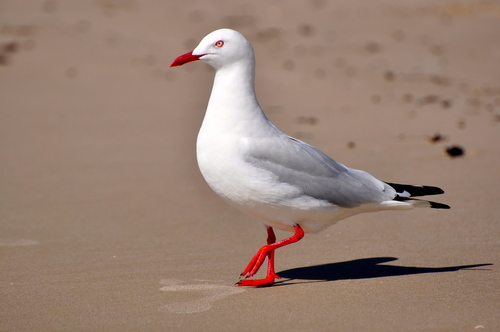
Silver Gull
The Silver Gull (*Chroicocephalus novaehollandiae*) is a common sight along the coasts of Australia, New Zealand, and New Caledonia. This adaptable bird thrives in a variety of habitats, from urban areas to remote islands. It plays a significant role in coastal ecosystems as both a scavenger and a predator of small marine life. While often considered a nuisance in some urban areas due to their scavenging habits, Silver Gulls are an integral part of the coastal environment. They are not considered globally threatened, demonstrating a remarkable ability to coexist with human activity.
37-43 cm
Length
91-96 cm
Wingspan
Least Concern
Conservation Status
Distribution
Primarily found along the coasts of Australia, New Zealand, and New Caledonia. Also found on surrounding islands and occasionally in Antarctica. They are generally non-migratory, but some populations may undertake local movements in response to food availability.
Lifespan
Typically 10-15 years in the wild, but can live longer in captivity.
Silver Gull's Habitat
Habitat Types
Coastal areas, Beaches, Estuaries, Harbors, Rocky shores, Urban areas near water, Landfill sites
Climate Zones
Temperate, Subtropical, Tropical (in New Caledonia)
Adaptations
Silver Gulls are highly adaptable to various food sources and environments. They possess webbed feet for efficient swimming and a relatively broad bill suitable for a diverse diet. They can tolerate a wide range of salinity levels.
Variations
Two subspecies are generally recognized: *C. n. novaehollandiae* (found in Australia and New Caledonia) and *C. n. scopulinus* (the Red-billed Gull, found in New Zealand, now often considered a separate species).
Appearance
Breeding Plumage
Adults in breeding plumage have a white head, body, and tail, with a light grey back and wings. Non-breeding adults have similar plumage but may have some faint brown streaking on the head.
Seasonal Feather Changes
Limited seasonal variation, primarily in head streaking.
Sex Based Plumage Differences
Minimal sexual dimorphism. Males may be slightly larger on average.
Notable Features
Bright red bill (in adults), Red eye-ring (in adults), Red legs and feet (in adults), Black wingtips with white 'mirrors' (small white patches)
Diet and Feeding
Primary Foods
Small fish, Crustaceans, Insects, Mollusks, Worms, Carrion, Human refuse
Foraging Behavior
Highly opportunistic feeders. They forage by walking, swimming, or flying. They are known to steal food from other birds and scavenge from human sources, including landfills and picnic areas. They also dip and dive for fish near the water's surface.
Specializations
Their broad bill allows them to consume a wide variety of food items. They are also adept at catching insects in flight.
Seasonal Diet Variations
Diet may shift depending on the availability of food. For example, they may consume more insects during the breeding season when feeding chicks.
Behavior
Social Structure
Highly social birds, often found in large flocks, especially outside of the breeding season. They breed in colonies, which can range from a few pairs to thousands of birds.
Communication
Loud, raucous calls, Visual displays, such as head-bobbing and wing-lifting, Contact calls to maintain flock cohesion
Migration
Generally non-migratory, although some populations may move locally in response to food availability or breeding opportunities.
Territorial or Group Behaviors
During the breeding season, pairs defend small territories around their nests. Outside of the breeding season, they are highly gregarious and form large flocks.
Conservation
Threats
Habitat loss and degradation, Disturbance at breeding colonies, Predation by introduced species (e.g., foxes, cats), Pollution (e.g., plastic ingestion), Human persecution (in some areas)
Protection Programs
Protection of breeding colonies, Habitat restoration, Control of introduced predators, Public education campaigns
Local National Laws
Protected under various state and national legislation in Australia and New Zealand.
Population Trend
Stable
Population Estimates
Global population estimated to be in the millions.
Interesting Facts
They are known to drop shellfish from a height onto rocks to break them open.
This demonstrates their intelligence and adaptability in obtaining food.
Silver Gulls can drink both freshwater and saltwater.
They have specialized salt glands above their eyes that allow them to excrete excess salt.
They often follow fishing boats and gather around trawlers to scavenge discarded fish.
This behavior highlights their opportunistic feeding habits.
Juvenile Silver Gulls have brown and white mottled plumage.
This provides camouflage and helps protect them from predators.
Faqs about Silver Gull
Are Silver Gulls dangerous to humans?
While generally not aggressive, Silver Gulls can become bold in their pursuit of food and may swoop at people carrying food. It's best to avoid feeding them and to keep food covered.
Why are there so many Silver Gulls in urban areas?
Silver Gulls are highly adaptable and have learned to exploit human-provided food sources, such as landfills, garbage bins, and discarded food scraps.
What should I do if I find an injured Silver Gull?
Contact your local wildlife rescue organization or a veterinarian. Do not attempt to handle the bird yourself unless you have experience with wildlife.
Do Silver Gulls mate for life?
Silver Gulls are believed to form pair bonds but it's not certain if these always last for life. Some studies show that 'divorce' can occur.
Copyright @ Nature Style Limited. All Rights Reserved.
 English
English